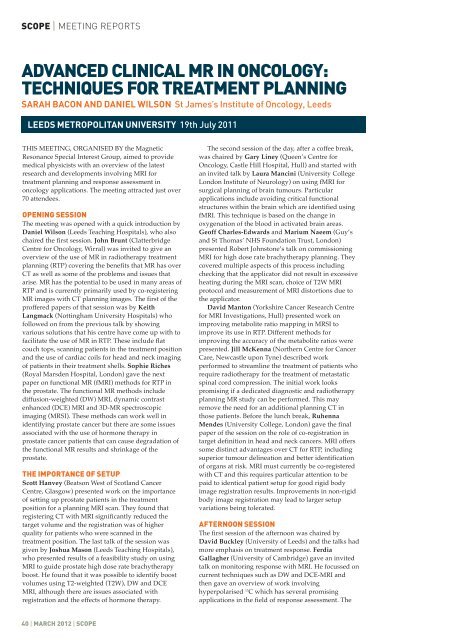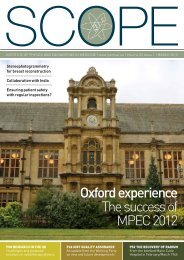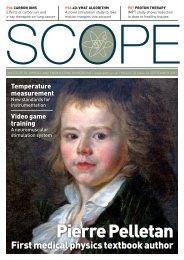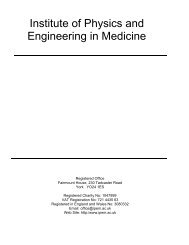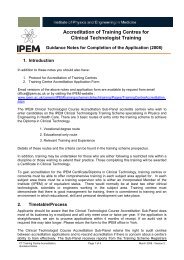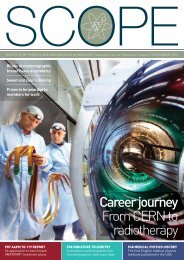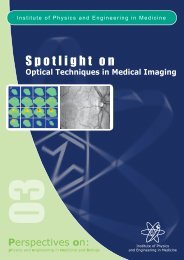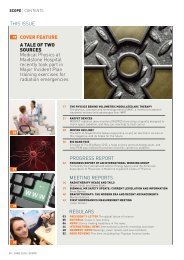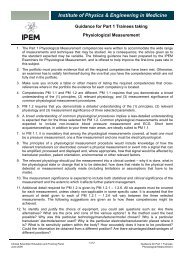March 2012 - Institute of Physics and Engineering in Medicine
March 2012 - Institute of Physics and Engineering in Medicine
March 2012 - Institute of Physics and Engineering in Medicine
Create successful ePaper yourself
Turn your PDF publications into a flip-book with our unique Google optimized e-Paper software.
SCOPE | MEETING REPORTS<br />
ADVANCED CLINICAL MR IN ONCOLOGY:<br />
TECHNIQUES FOR TREATMENT PLANNING<br />
SARAH BACON AND DANIEL WILSON St James’s <strong>Institute</strong> <strong>of</strong> Oncology, Leeds<br />
LEEDS METROPOLITAN UNIVERSITY 19th July 2011<br />
THIS MEETING, ORGANISED BY the Magnetic<br />
Resonance Special Interest Group, aimed to provide<br />
medical physicists with an overview <strong>of</strong> the latest<br />
research <strong>and</strong> developments <strong>in</strong>volv<strong>in</strong>g MRI for<br />
treatment plann<strong>in</strong>g <strong>and</strong> response assessment <strong>in</strong><br />
oncology applications. The meet<strong>in</strong>g attracted just over<br />
70 attendees.<br />
OPENING SESSION<br />
The meet<strong>in</strong>g was opened with a quick <strong>in</strong>troduction by<br />
Daniel Wilson (Leeds Teach<strong>in</strong>g Hospitals), who also<br />
chaired the first session. John Brunt (Clatterbridge<br />
Centre for Oncology, Wirral) was <strong>in</strong>vited to give an<br />
overview <strong>of</strong> the use <strong>of</strong> MR <strong>in</strong> radiotherapy treatment<br />
plann<strong>in</strong>g (RTP) cover<strong>in</strong>g the benefits that MR has over<br />
CT as well as some <strong>of</strong> the problems <strong>and</strong> issues that<br />
arise. MR has the potential to be used <strong>in</strong> many areas <strong>of</strong><br />
RTP <strong>and</strong> is currently primarily used by co-register<strong>in</strong>g<br />
MR images with CT plann<strong>in</strong>g images. The first <strong>of</strong> the<br />
pr<strong>of</strong>fered papers <strong>of</strong> that session was by Keith<br />
Langmack (Nott<strong>in</strong>gham University Hospitals) who<br />
followed on from the previous talk by show<strong>in</strong>g<br />
various solutions that his centre have come up with to<br />
facilitate the use <strong>of</strong> MR <strong>in</strong> RTP. These <strong>in</strong>clude flat<br />
couch tops, scann<strong>in</strong>g patients <strong>in</strong> the treatment position<br />
<strong>and</strong> the use <strong>of</strong> cardiac coils for head <strong>and</strong> neck imag<strong>in</strong>g<br />
<strong>of</strong> patients <strong>in</strong> their treatment shells. Sophie Riches<br />
(Royal Marsden Hospital, London) gave the next<br />
paper on functional MR (fMRI) methods for RTP <strong>in</strong><br />
the prostate. The functional MR methods <strong>in</strong>clude<br />
diffusion-weighted (DW) MRI, dynamic contrast<br />
enhanced (DCE) MRI <strong>and</strong> 3D-MR spectroscopic<br />
imag<strong>in</strong>g (MRSI). These methods can work well <strong>in</strong><br />
identify<strong>in</strong>g prostate cancer but there are some issues<br />
associated with the use <strong>of</strong> hormone therapy <strong>in</strong><br />
prostate cancer patients that can cause degradation <strong>of</strong><br />
the functional MR results <strong>and</strong> shr<strong>in</strong>kage <strong>of</strong> the<br />
prostate.<br />
THE IMPORTANCE OF SETUP<br />
Scott Hanvey (Beatson West <strong>of</strong> Scotl<strong>and</strong> Cancer<br />
Centre, Glasgow) presented work on the importance<br />
<strong>of</strong> sett<strong>in</strong>g up prostate patients <strong>in</strong> the treatment<br />
position for a plann<strong>in</strong>g MRI scan. They found that<br />
register<strong>in</strong>g CT with MRI significantly reduced the<br />
target volume <strong>and</strong> the registration was <strong>of</strong> higher<br />
quality for patients who were scanned <strong>in</strong> the<br />
treatment position. The last talk <strong>of</strong> the session was<br />
given by Joshua Mason (Leeds Teach<strong>in</strong>g Hospitals),<br />
who presented results <strong>of</strong> a feasibility study on us<strong>in</strong>g<br />
MRI to guide prostate high dose rate brachytherapy<br />
boost. He found that it was possible to identify boost<br />
volumes us<strong>in</strong>g T2-weighted (T2W), DW <strong>and</strong> DCE<br />
MRI, although there are issues associated with<br />
registration <strong>and</strong> the effects <strong>of</strong> hormone therapy.<br />
The second session <strong>of</strong> the day, after a c<strong>of</strong>fee break,<br />
was chaired by Gary L<strong>in</strong>ey (Queen’s Centre for<br />
Oncology, Castle Hill Hospital, Hull) <strong>and</strong> started with<br />
an <strong>in</strong>vited talk by Laura Manc<strong>in</strong>i (University College<br />
London <strong>Institute</strong> <strong>of</strong> Neurology) on us<strong>in</strong>g fMRI for<br />
surgical plann<strong>in</strong>g <strong>of</strong> bra<strong>in</strong> tumours. Particular<br />
applications <strong>in</strong>clude avoid<strong>in</strong>g critical functional<br />
structures with<strong>in</strong> the bra<strong>in</strong> which are identified us<strong>in</strong>g<br />
fMRI. This technique is based on the change <strong>in</strong><br />
oxygenation <strong>of</strong> the blood <strong>in</strong> activated bra<strong>in</strong> areas.<br />
Ge<strong>of</strong>f Charles-Edwards <strong>and</strong> Marium Naeem (Guy’s<br />
<strong>and</strong> St Thomas’ NHS Foundation Trust, London)<br />
presented Robert Johnstone’s talk on commission<strong>in</strong>g<br />
MRI for high dose rate brachytherapy plann<strong>in</strong>g. They<br />
covered multiple aspects <strong>of</strong> this process <strong>in</strong>clud<strong>in</strong>g<br />
check<strong>in</strong>g that the applicator did not result <strong>in</strong> excessive<br />
heat<strong>in</strong>g dur<strong>in</strong>g the MRI scan, choice <strong>of</strong> T2W MRI<br />
protocol <strong>and</strong> measurement <strong>of</strong> MRI distortions due to<br />
the applicator.<br />
David Manton (Yorkshire Cancer Research Centre<br />
for MRI Investigations, Hull) presented work on<br />
improv<strong>in</strong>g metabolite ratio mapp<strong>in</strong>g <strong>in</strong> MRSI to<br />
improve its use <strong>in</strong> RTP. Different methods for<br />
improv<strong>in</strong>g the accuracy <strong>of</strong> the metabolite ratios were<br />
presented. Jill McKenna (Northern Centre for Cancer<br />
Care, Newcastle upon Tyne) described work<br />
performed to streaml<strong>in</strong>e the treatment <strong>of</strong> patients who<br />
require radiotherapy for the treatment <strong>of</strong> metastatic<br />
sp<strong>in</strong>al cord compression. The <strong>in</strong>itial work looks<br />
promis<strong>in</strong>g if a dedicated diagnostic <strong>and</strong> radiotherapy<br />
plann<strong>in</strong>g MR study can be performed. This may<br />
remove the need for an additional plann<strong>in</strong>g CT <strong>in</strong><br />
those patients. Before the lunch break, Ruhenna<br />
Mendes (University College, London) gave the f<strong>in</strong>al<br />
paper <strong>of</strong> the session on the role <strong>of</strong> co-registration <strong>in</strong><br />
target def<strong>in</strong>ition <strong>in</strong> head <strong>and</strong> neck cancers. MRI <strong>of</strong>fers<br />
some dist<strong>in</strong>ct advantages over CT for RTP, <strong>in</strong>clud<strong>in</strong>g<br />
superior tumour del<strong>in</strong>eation <strong>and</strong> better identification<br />
<strong>of</strong> organs at risk. MRI must currently be co-registered<br />
with CT <strong>and</strong> this requires particular attention to be<br />
paid to identical patient setup for good rigid body<br />
image registration results. Improvements <strong>in</strong> non-rigid<br />
body image registration may lead to larger setup<br />
variations be<strong>in</strong>g tolerated.<br />
AFTERNOON SESSION<br />
The first session <strong>of</strong> the afternoon was chaired by<br />
David Buckley (University <strong>of</strong> Leeds) <strong>and</strong> the talks had<br />
more emphasis on treatment response. Ferdia<br />
Gallagher (University <strong>of</strong> Cambridge) gave an <strong>in</strong>vited<br />
talk on monitor<strong>in</strong>g response with MRI. He focussed on<br />
current techniques such as DW <strong>and</strong> DCE-MRI <strong>and</strong><br />
then gave an overview <strong>of</strong> work <strong>in</strong>volv<strong>in</strong>g<br />
hyperpolarised 13 C which has several promis<strong>in</strong>g<br />
applications <strong>in</strong> the field <strong>of</strong> response assessment. The<br />
40 | MARCH <strong>2012</strong> | SCOPE


